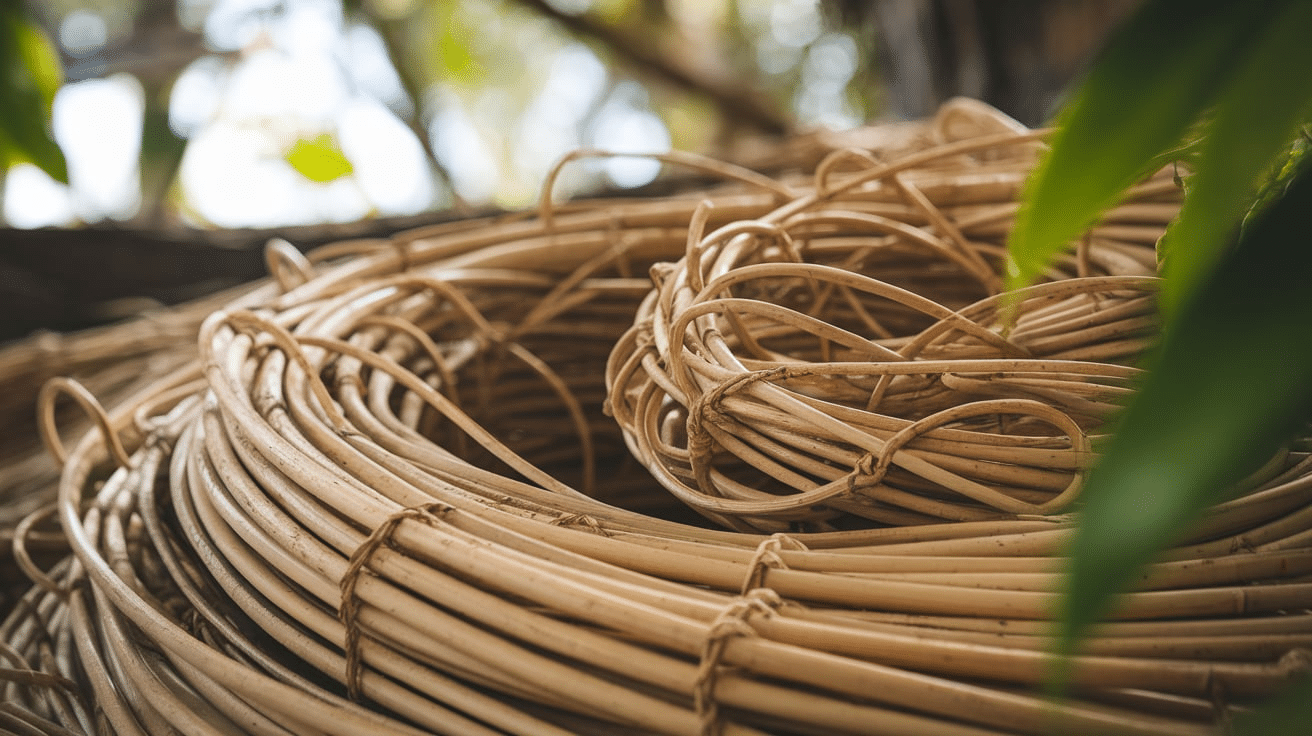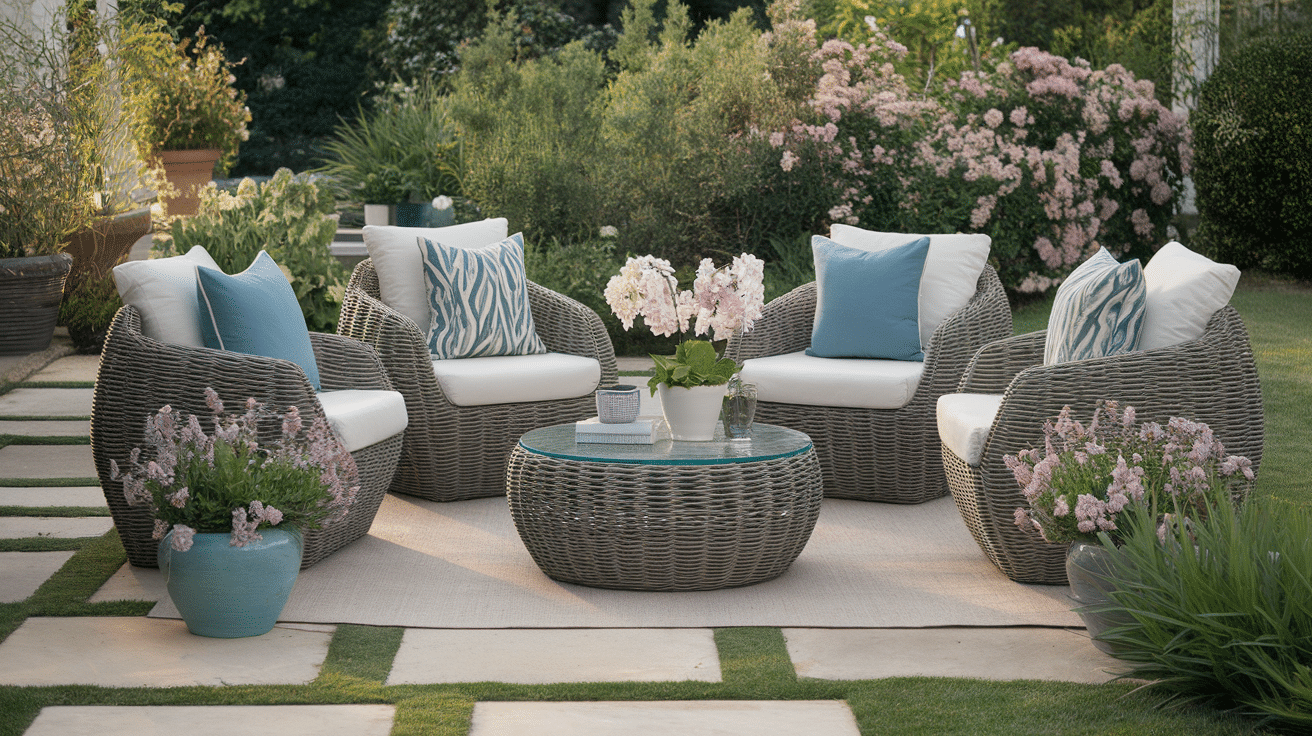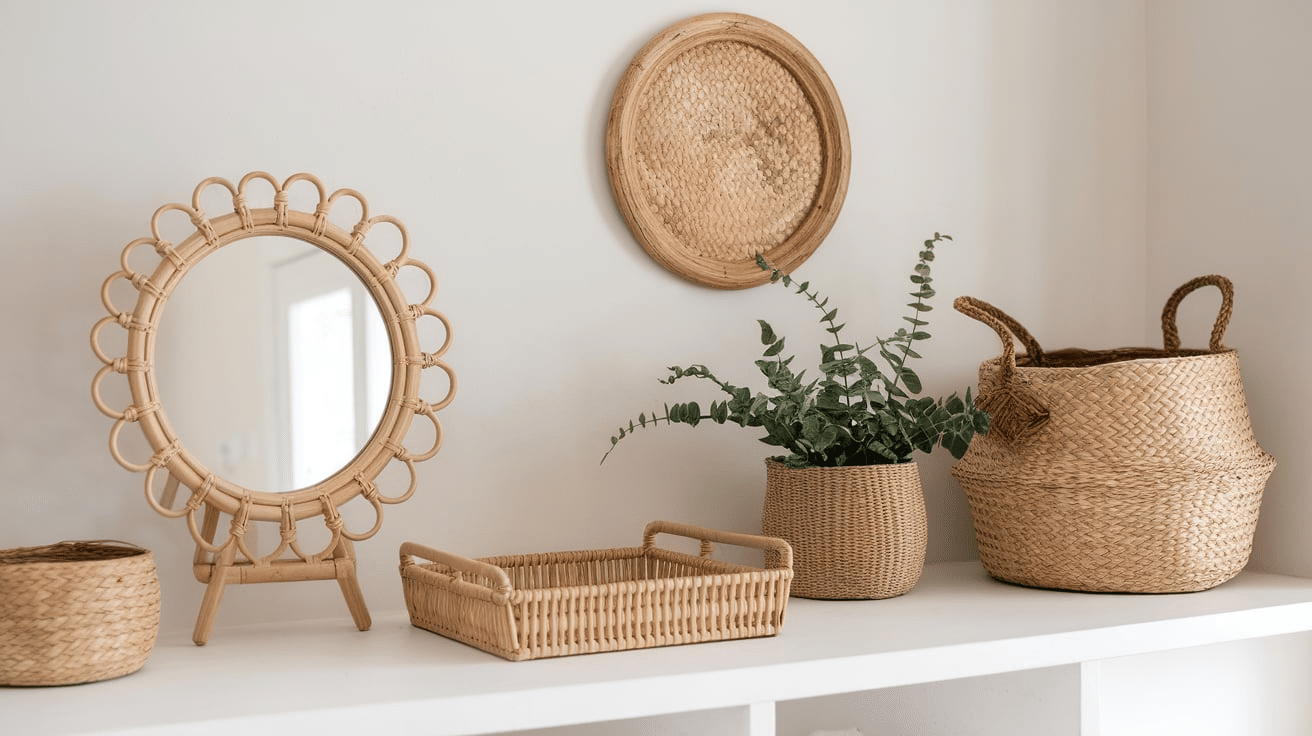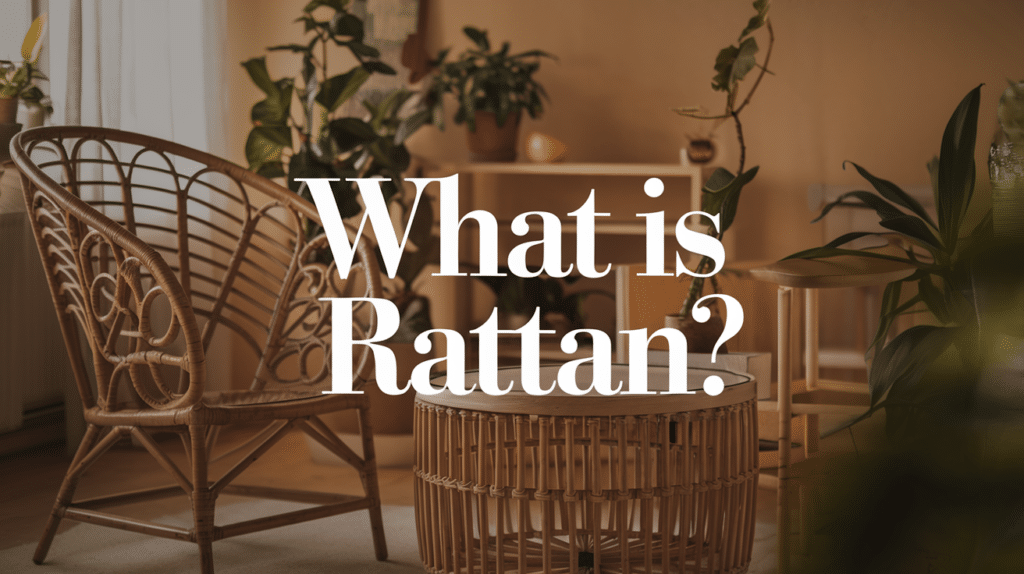Looking for a way to bring nature into your home? Rattan might be just what you need.
Rattan is a natural material that comes from the stems of climbing palm plants. These plants grow in warm, tropical places. For years, people have used rattan to make baskets and tools. But today, it’s more popular than ever—especially in furniture.
You’ll see rattan chairs, tables, and shelves in both indoor and outdoor spaces. Its light color and woven style fit well in many homes. It also adds a warm and natural feel without trying too hard.
In this blog, we’ll look at what rattan is and how it’s different from things like wicker, cane, and reed. We’ll also go over its benefits, common uses, and simple care tips. By the end, you’ll see why so many people are bringing rattan into their spaces.
What Is Rattan?

Rattan is a vine-like plant that grows in tropical areas, mostly in Southeast Asia. It climbs up trees in rainforests and can stretch for hundreds of feet.
While it may look like wood, rattan is actually a fast-growing grass with a solid core, which is what distinguishes it from bamboo.
One reason rattan is so useful is because of its natural features. It is strong, flexible, and doesn’t break easily. At the same time, it’s light, which makes it simple to carry and work with. These traits make it perfect for crafting all kinds of items.
For centuries, people have used rattan to make furniture, baskets, and decorations. Its smooth surface and bendable shape allow crafters to form it into chairs, headboards, shelves, and more. Rattan also works well for weaving and wrapping, which adds texture and interest to any item.
Because it’s both useful and natural, rattan continues to be a favorite in homes around the world.
Rattan vs. Wicker: What’s the Difference?

Many people think rattan and wicker are the same, but they’re not. Rattan is the actual plant that’s used to build furniture. Wicker is the weaving style used to shape that furniture.
Rattan grows like a vine in tropical places and has a solid, bendable stem. It can be cut into thick poles or thin strips. These are then used to build or weave furniture.
Wicker is the way those thin strips are woven into patterns. It doesn’t matter what material is used—rattan, bamboo, or plastic can all be woven in this way. So wicker is more about the look and design, not the material itself.
| Feature | Rattan | Wicker |
|---|---|---|
| Type | Natural plant material | Weaving technique |
| Source | Grows in tropical climates like Southeast Asia | Not a plant—used with many materials |
| Main Use | Building frames and solid parts of furniture | Creating patterns and surfaces |
| Material Examples | Rattan, cane, reed | Rattan, bamboo, reed, plastic |
| Texture | Smooth and solid | Patterned and woven |
| Function | Adds structure and support | Adds design and surface style |
Rattan, Cane, and Reed: Key Differences

The rattan plant can be used in more than one way. After it’s harvested, it is split into different parts. Each part—rattan, cane, and reed—has its own job in furniture and decor.
Cane is taken from the outer layer of the rattan stem and peeled into thin, smooth strips that are easy to weave. These strips are often used in chair backs, cabinet panels, and other flat surfaces.
Reed comes from the center of the rattan stem. It is thicker than cane and has a rougher feel. Because it holds its shape well, it is often used in baskets and other woven items.
| Feature | Rattan | Cane | Reed |
|---|---|---|---|
| Source | Full rattan stem | Outer bark of rattan | Inner core of rattan |
| Texture | Smooth and solid | Very smooth and flat | Slightly rough and thicker |
| Strength | Strong and long-lasting | Strong but thin | Rigid and firm |
| Flexibility | Bends when heated | Flexible and good for weaving | Less flexible, holds firm shapes |
| Common Uses | Furniture frames, decor | Chair seats, panels, drawer fronts | Baskets, trays, structured decor items |
Characteristics and Benefits of Rattan Furniture
Rattan furniture is popular because it blends beauty with function. It’s lightweight, strong, and easy to work with, which makes it useful in many areas of the home. These qualities help explain why rattan continues to be a trusted choice.
1. Durable and Lightweight
Rattan is strong enough for daily use without wearing out quickly. It can hold weight and handle movement, making it dependable for everyday use. You don’t have to worry about it breaking down under normal use.
Even though it’s tough, rattan is also light. You can move a rattan chair or table without much effort. This is helpful if you like to rearrange your space often.
Because it’s both light and sturdy, rattan works well in many spots. It’s good for homes with kids, guests or even small spaces. You get something that lasts but doesn’t feel bulky.
2. Flexible and Easy to Shape
Rattan bends easily when heated or soaked, which makes it great for curved designs. This is useful when creating round backs, arms, or legs on furniture. It also helps give each piece a soft and natural look.
This flexibility is part of what makes rattan stand out. Instead of sharp lines, you get smooth curves and flowing shapes, which also add comfort to the design.
Crafters can make many styles using this bendable material. From the same base plant, they can build simple and detailed items. That’s one reason rattan is used in so many ways.
3. Works with Many Styles
Rattan is well-suited for farmhouse, beach, tropical, and rustic looks. It adds a natural touch without being too bold, making it easy to mix with other furniture or colors.
Its light color and soft texture bring warmth into any space. It can be used in living rooms, bedrooms, or outdoor areas. It blends in while still adding something special.
Even one rattan piece can change how a room feels. A rattan chair, mirror, or basket can add interest without taking over, which is part of what makes it easy to use.
Where Rattan Is Commonly Used in Homes
Rattan can be found in many areas of the home. It works well in both large furniture and small decorative items. Its natural look and light weight make it a favorite in many rooms.
1. Indoor Furniture

Rattan is often used to make chairs, sofas, and tables. You’ll also see it in bed frames, headboards, and bookshelves. These pieces add a soft, natural feel to any space.
Many rattan pieces are paired with fabric or cushions, which makes them more comfortable for daily use and allows you to mix colors and patterns for a cozy setup.
Rattan is a good choice for both small and large rooms. Its light weight makes it easy to move around, and you can change your setup without a lot of effort.
2. Outdoor Furniture

Rattan is a common pick for patios and garden areas. It looks good outside and fits well with plants and open air. Synthetic rattan is often used because it holds up better in the weather.
Outdoor rattan furniture is often treated to resist sun and rain. This helps it last longer in changing weather. With the right care, it can stay in good shape for years.
Rattan chairs, lounges, and tables work well outdoors. They are light enough to move around but strong enough to use every day, making them both helpful and easy to enjoy.
3. Home Accessories

Rattan is also used for smaller items around the house. You might see it in baskets, trays, or planters. These items add texture without taking up much space.
It also shows up in mirror frames, pendant lights, and wall hangings. These touches give a room a softer, natural style. You don’t need to change your whole setup to feel the difference.
Adding one or two rattan pieces can make a space feel more relaxed. It’s a simple way to incorporate natural materials, and you can achieve style and function without spending much.
How to Care for Rattan Furniture
Rattan furniture doesn’t need a lot of work, but regular care helps it last longer. With the right cleaning, protection, and repair steps, you can keep your rattan pieces looking good year after year.
- Cleaning: Dust often with a dry cloth or soft brush to keep dirt from building up.
- Washing: Use a soft cloth and mild soapy water to wipe it down, then dry it right away.
- Water Use: Avoid soaking the furniture or using too much water, as this can cause damage.
- Sun Protection: Keep rattan out of direct sunlight when outdoors to avoid fading or cracking.
- Sealant: Apply a clear sealant or top coat to outdoor pieces for extra weather protection.
- Loose Weaves: Press any loose strands gently back into place to keep the shape firm.
- Scratches: Rub fine sandpaper lightly over small scratches to smooth the surface.
- Dry Spots: Use boiled linseed oil on dry or faded areas to bring back moisture and shine.
With just a few simple steps, you can keep your rattan looking nice and working well. A little care goes a long way in keeping your furniture strong and stylish.
Conclusion
Rattan comes from climbing palm plants in tropical areas. It’s known for being strong, bendable, and easy to shape. People use it for making furniture and home items that feel warm and natural.
One of the best things about rattan is that it’s eco-friendly. It grows fast and doesn’t need harsh chemicals to be useful. It also holds up well, making it a smart choice for long-lasting items. You can use it in many places, from patios to bedrooms.
Because it blends well with different colors and materials, it fits many styles of home design. It doesn’t stand out too much, but it still adds interest.
If you’re unsure about trying rattan, start small. A basket, mirror frame, or side table can bring in that natural look. Over time, you might even want to add a chair or a full set.
Rattan is simple, useful and brings nature indoors.
Frequently Asked Questions
Can Rattan Furniture Be Painted?
Yes, rattan furniture can be painted. Use spray paint or a brush with a light hand for the best results. Make sure the surface is clean and dry before painting.
Is Rattan Safe Around Pets?
Rattan is generally safe around pets, but some animals like to chew on it. If your pet tends to bite furniture, rattan might not last as long. Try placing pet toys nearby to help distract them.
How Can I Tell If Rattan Is Real Or Synthetic?
Real rattan feels more natural and may show small bumps or slight color changes. Synthetic rattan is usually smoother and has a plastic feel. You can also check the product label or ask the seller for details.
Does Rattan Work In Cold Climates?
Rattan can be used in cold places, but it’s best kept indoors during the winter. Cold, dry air can make it brittle over time. If used outside, store it indoors or cover it during harsh weather.
Can Rattan Furniture Be Used In Bathrooms?
Yes, but only in well-ventilated bathrooms. Too much moisture can damage natural rattan. Try to keep it away from direct splashes or place it in drier corners.

